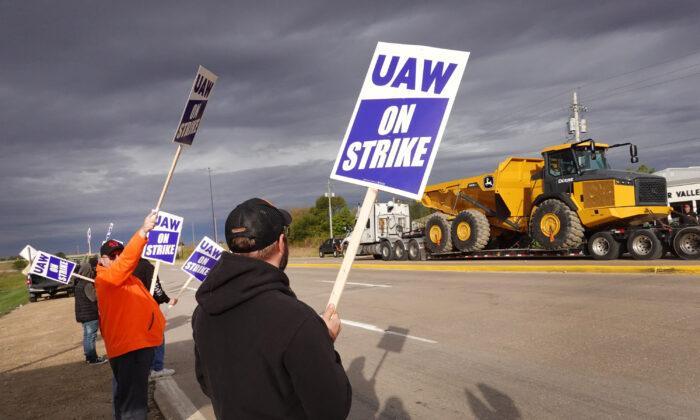Roughly 10,000 members of the United Auto Workers (UAW) union have been on strike against Deere & Company, the parent company of farm and construction equipment maker John Deere, since midnight on Oct. 14.
The strike is the largest of the pandemic era and also the largest private-sector walkout since the UAW’s action against General Motors in 2019.
Genesis of the Conflict
The strike against Deere is the first labor action against the company in 35 years and shuts down shuts operations at 11 factories in Illinois, Iowa and Kansas, plus three distribution centers in Colorado, Georgia and Illinois.The UAW and Deere negotiated a contract that would have raised the base pay of union members by up to 6 percent plus additional wage hikes totaling approximately 20 percent trover the coming six years. It would have also erased a lower tier of pay for some recently hired workers and returned the cost-of-living adjustment to the union contract.
Part of a Trend
There has been a new wave of labor strikes across the country that includes approximately 1,400 cereal production workers in Michigan, Nebraska, Pennsylvania and Tennessee on strike against Kellogg Company; 2,000 nurses, technical, and clerical employees on strike against Mercy Hospital in South Buffalo, New York; and 1,000 employees of Warrior Met Coal in Alabama.Hollywood faced the threat of a strike by members of the International Alliance of Theatrical Stage Employees that would have halted film and television production, but that walkout was averted.
Potential Economic Impact
The timing of the strike couldn’t have been worse, as the United States economy is struggling with a tag team of rising inflation and supply chain disruptions.Farmers were facing shortages of agricultural equipment and parts before the strike began and this exacerbates the situation. Lance Lillibridge, a farmer and president of the Iowa Corn Growers Association, told NewsNation.com that not having replacement parts for his John Deere equipment could result in crops not being readied for distribution.
Potential Impact to Deere
The strike occurs five months after Deere’s stock hit a record peak of new all-time high of just over $400.34 per share. The stock was trading at the $344 level Wednesday afternoon.Deere is facing the strike in a strong financial position. According to its most recent earnings report, the third-quarter data published on Aug. 20, the company reported net income of $1.6 billion, up from $811 million one year earlier. Worldwide net sales and revenues increased 29 percent to $11.5 billion and net sales of the equipment operations were $10.4 billion.
Ironically, CEO John May announced the third-quarter data by crediting the quarterly results to “the exceptional efforts of our employees and dealers to keep our factories running and customers served while enduring significant supply-chain pressures.”
The Road to Resolution
As of this writing, both sides are working on a settlement. Brad Morris, vice president of labor relations for Deere, insisted the company “will keep working day and night to understand our employees’ priorities and resolve this strike.”However, the union is not showing signs that it is seeking a quick end to its action.
“These are skilled, tedious jobs that UAW members take pride in every day,” said Mitchell Smith, UAW Region 8 director. “Strikes are never easy on workers or their families but John Deere workers believe they deserve a better share of the pie, a safer workplace, and adequate benefits.”





